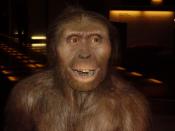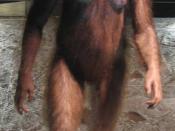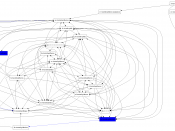Hominid evolution and the eventual rise of modern humans is thought to be a rather vague science by many unfamiliar with the field. The public at large (that is, those that have never taken a physical anthropology class) would not be able to recognize the hominids Australopithecus bahr el grazel, or even Australopithecus habilus. It is however, likely that they would be able to recall the well-publicized Lucy (or Australopithecus afarensis to the paleoanthropologically savvy). For the everyday Joe, human evolution begins with A. afarensis, passes through Homo neanderthalensis and ends with us (which is quite clearly incorrect). Indeed, A. afarensis had been, prior to 1994, the sole root of our family tree as a species (Culotta, 1995: 918). However, this all changed when in 1994, and then 1995, remains of hominid species older than A. afarensis were found (1995: 918).
Ardipithecus ramidus discovered in 1994 by Tim White and crew, and then Austrolapithecus anamensis in 1995 by Meave Leake and crew, are the earliest pieces to the puzzle of hominid evolution (Smithsonian Institution, 2000).
The problem then, is figuring out how these pieces fit in with the rest of the puzzle. A. anamensis's features closely resemble those of the apes, however a number of derived traits suggest relation to later australopithecines (Boyd, Silk, 2000: 340). Thus, A. anamensis may or may not be the ancestor of A. afarensis, but certainly shares some common ancestor with it (Leake et al, 1995: 568). A quick look at the phylogenetic tree shows us that if we are to accept the connection between A. anamensis and A. afarensis, and then from A. afarensis to all other
later hominids, all hominids have commonality with A. anamensis (Smithsonian Institution 2000). Alan Walker, who was a member of the party responsible for the tremendous discovery remarks...



Nice work citing all sources
very well writin
2 out of 2 people found this comment useful.